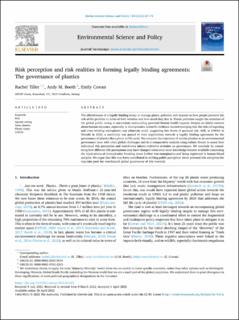| dc.contributor.author | Tiller, Rachel Gjelsvik | |
| dc.contributor.author | Booth, Andrew | |
| dc.contributor.author | Cowan, Emily Christine | |
| dc.date.accessioned | 2022-08-05T10:36:09Z | |
| dc.date.available | 2022-08-05T10:36:09Z | |
| dc.date.created | 2022-04-27T14:12:46Z | |
| dc.date.issued | 2022 | |
| dc.identifier.citation | Environmental Science and Policy. 2022, 134 67-74. | en_US |
| dc.identifier.issn | 1462-9011 | |
| dc.identifier.uri | https://hdl.handle.net/11250/3010331 | |
| dc.description.abstract | The effectiveness of a legally binding treaty to manage plastic pollution will depend on how people perceive the risk of the problem in terms of both whether and how much they fear it. Plastic pollution caught the attention of the global public owing to uncertainty surrounding potential human health impacts. Despite an initial concern about human exposure, especially to microplastics, scientific evidence started emerging that the risks of ingesting and even inhaling microplastic was relatively small, suggesting low levels of personal risk. Still, at UNEA5 in Nairobi in 2022, a resolution was passed to start negotiations towards a legally binding agreement for the governance of plastics throughout its life cycle. We compare the trajectory of marine plastics as an environmental governance issue with other global challenges and do a comparative analysis using culture theory to assess how individual risk perception and worldviews inform collective attitudes on governance. We conclude by considering how different risk perceptions may have changed when even more knowledge became available concerning the implications of microplastics breaking down further into nanoplastics and being registered in human blood samples. We argue that this may have contributed to shifting public perception about personal risk and given the requisite push for coordinated global governance of this material. | en_US |
| dc.language.iso | eng | en_US |
| dc.publisher | Elsevier | en_US |
| dc.rights | Navngivelse 4.0 Internasjonal | * |
| dc.rights.uri | http://creativecommons.org/licenses/by/4.0/deed.no | * |
| dc.subject | UNEA5 | en_US |
| dc.subject | Plastic treaty | en_US |
| dc.subject | Nano plastics | en_US |
| dc.subject | Agenda setting | en_US |
| dc.subject | Risk | en_US |
| dc.title | Risk perception and risk realities in forming legally binding agreements: The governance of plastics | en_US |
| dc.title.alternative | Risk perception and risk realities in forming legally binding agreements: The governance of plastics | en_US |
| dc.type | Peer reviewed | en_US |
| dc.type | Journal article | en_US |
| dc.description.version | publishedVersion | en_US |
| dc.rights.holder | © 2022 The Author(s). Published by Elsevier Ltd | en_US |
| dc.source.pagenumber | 67-74 | en_US |
| dc.source.volume | 134 | en_US |
| dc.source.journal | Environmental Science and Policy | en_US |
| dc.identifier.doi | 10.1016/j.envsci.2022.04.002 | |
| dc.identifier.cristin | 2019568 | |
| dc.relation.project | Norges forskningsråd: 318730 | en_US |
| dc.relation.project | Norges forskningsråd: 315402 | en_US |
| cristin.ispublished | true | |
| cristin.fulltext | original | |
| cristin.qualitycode | 1 | |

